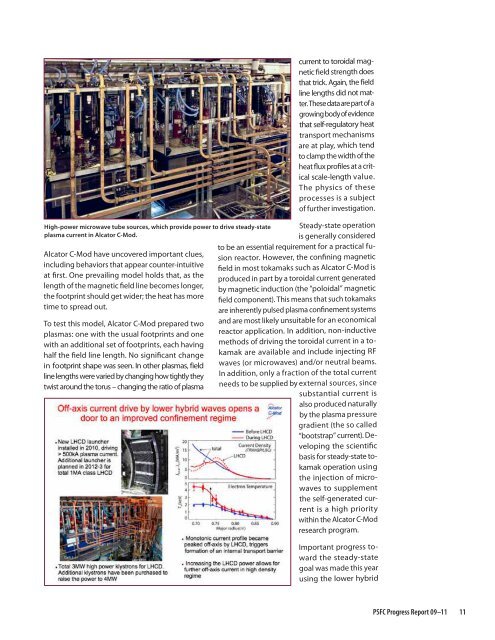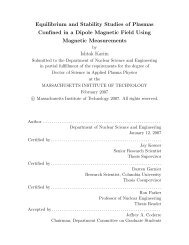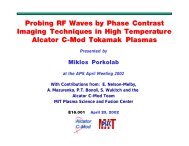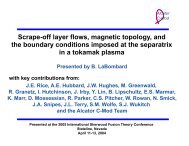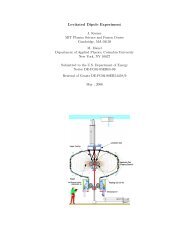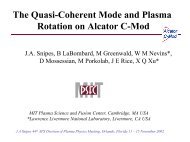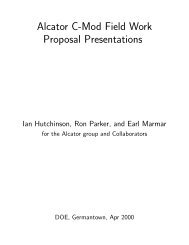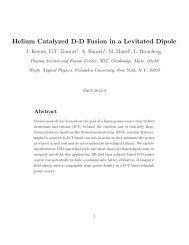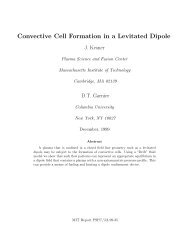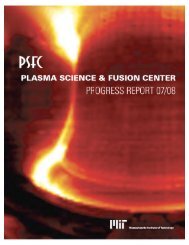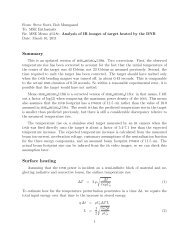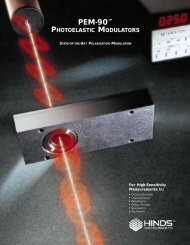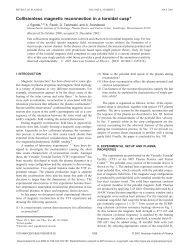Download a copy of the latest PSFC Progress Report - Plasma ...
Download a copy of the latest PSFC Progress Report - Plasma ...
Download a copy of the latest PSFC Progress Report - Plasma ...
You also want an ePaper? Increase the reach of your titles
YUMPU automatically turns print PDFs into web optimized ePapers that Google loves.
current to toroidal magnetic<br />
field strength does<br />
that trick. Again, <strong>the</strong> field<br />
line lengths did not matter.<br />
These data are part <strong>of</strong> a<br />
growing body <strong>of</strong> evidence<br />
that self-regulatory heat<br />
transport mechanisms<br />
are at play, which tend<br />
to clamp <strong>the</strong> width <strong>of</strong> <strong>the</strong><br />
heat flux pr<strong>of</strong>iles at a critical<br />
scale-length value.<br />
The physics <strong>of</strong> <strong>the</strong>se<br />
processes is a subject<br />
<strong>of</strong> fur<strong>the</strong>r investigation.<br />
High-power microwave tube sources, which provide power to drive steady-state<br />
plasma current in Alcator C-Mod.<br />
Alcator C-Mod have uncovered important clues,<br />
including behaviors that appear counter-intuitive<br />
at first. One prevailing model holds that, as <strong>the</strong><br />
length <strong>of</strong> <strong>the</strong> magnetic field line becomes longer,<br />
<strong>the</strong> footprint should get wider; <strong>the</strong> heat has more<br />
time to spread out.<br />
To test this model, Alcator C-Mod prepared two<br />
plasmas: one with <strong>the</strong> usual footprints and one<br />
with an additional set <strong>of</strong> footprints, each having<br />
half <strong>the</strong> field line length. No significant change<br />
in footprint shape was seen. In o<strong>the</strong>r plasmas, field<br />
line lengths were varied by changing how tightly <strong>the</strong>y<br />
twist around <strong>the</strong> torus – changing <strong>the</strong> ratio <strong>of</strong> plasma<br />
Steady-state operation<br />
is generally considered<br />
to be an essential requirement for a practical fusion<br />
reactor. However, <strong>the</strong> confining magnetic<br />
field in most tokamaks such as Alcator C-Mod is<br />
produced in part by a toroidal current generated<br />
by magnetic induction (<strong>the</strong> ”poloidal” magnetic<br />
field component). This means that such tokamaks<br />
are inherently pulsed plasma confinement systems<br />
and are most likely unsuitable for an economical<br />
reactor application. In addition, non-inductive<br />
methods <strong>of</strong> driving <strong>the</strong> toroidal current in a tokamak<br />
are available and include injecting RF<br />
waves (or microwaves) and/or neutral beams.<br />
In addition, only a fraction <strong>of</strong> <strong>the</strong> total current<br />
needs to be supplied by external sources, since<br />
substantial current is<br />
also produced naturally<br />
by <strong>the</strong> plasma pressure<br />
gradient (<strong>the</strong> so called<br />
“bootstrap” current). Developing<br />
<strong>the</strong> scientific<br />
basis for steady-state tokamak<br />
operation using<br />
<strong>the</strong> injection <strong>of</strong> microwaves<br />
to supplement<br />
<strong>the</strong> self-generated current<br />
is a high priority<br />
within <strong>the</strong> Alcator C-Mod<br />
research program.<br />
Important progress toward<br />
<strong>the</strong> steady-state<br />
goal was made this year<br />
using <strong>the</strong> lower hybrid<br />
<strong>PSFC</strong> <strong>Progress</strong> <strong>Report</strong> 09–11 11


